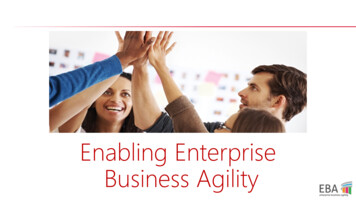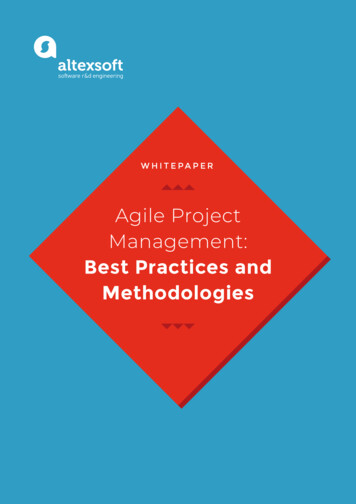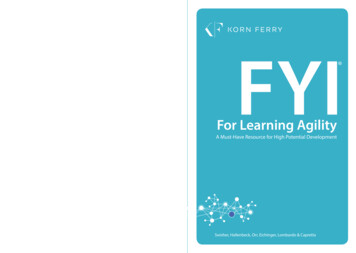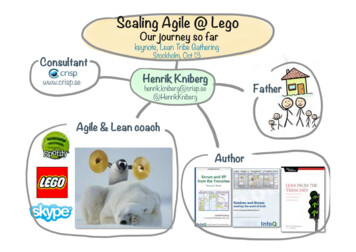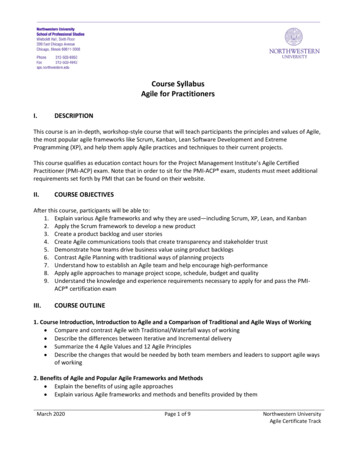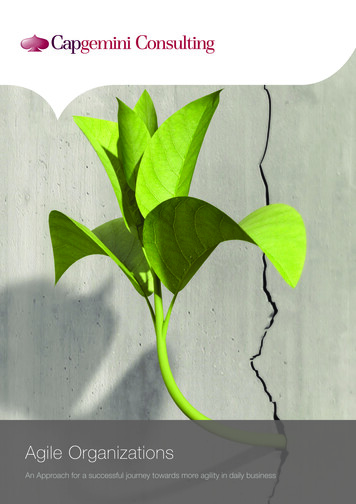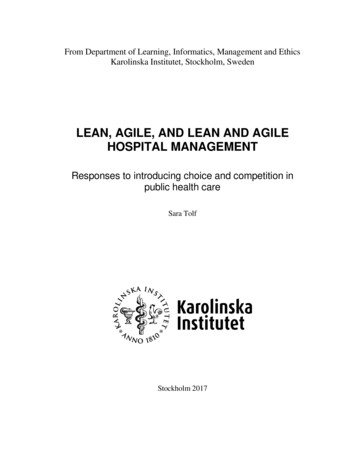
Transcription
Brilliant AgileProjectManagementUK: 44 (0)330 043 0143US: d.comThe Coach House48 New Park StreetDevizes, WiltshireSN10 1DSUnited KingdomAgility in Mind LimitedRegistered in England & WalesNumber 7289974
brilliant agile projectmanagementFor proof only - Not for distributionA01 COLE3560 01 SE FM.indd 110/26/15 11:05 AM
For proof only - Not for distributionA01 COLE3560 01 SE FM.indd 210/26/15 11:05 AM
brilliantagile projectmanagementA practical guide tousing Agile, Scrumand KanbanRob Cole and Edward ScotcherFor proof only - Not for distributionA01 COLE3560 01 SE FM.indd 310/26/15 11:05 AM
Pearson Education LimitedEdinburgh GateHarlow CM20 2JEUnited KingdomTel: 44 (0)1279 623623Web: www.pearson.com/ukFirst published 2015 (print and electronic) Lexray Limited and Agility in Mind Limited, 2015 (print and electronic)The print publication is protected by copyright. Prior to any prohibited reproduction,storage in a retrieval system, distribution or transmission in any form or by any means,electronic, mechanical, recording or otherwise, permission should be obtained from thepublisher or, where applicable, a licence permitting restricted copying in the UnitedKingdom should be obtained from the Copyright Licensing Agency Ltd, Barnard’s Inn, 86Fetter Lane, London EC4A 1EN.The ePublication is protected by copyright and must not be copied, reproduced, transferred, distributed, leased, licensed or publicly performed or used in any way except asspecifically permitted in writing by the publishers, as allowed under the terms and conditions under which it was purchased, or as strictly permitted by applicable copyrightlaw. Any unauthorised distribution or use of this text may be a direct infringement of theauthors’ and the publisher’s rights and those responsible may be liable in law accordingly.Pearson Education is not responsible for the content of third-party internet sites.ISBN: 9 78–1-292–06356–0 (print) 978–1-292–06358–4 (PDF) 978–1-292–06357–7 (eText)978–1-292–06359–1 (ePub)British Library Cataloguing-in-Publication DataCole, Rob, author.Brilliant Agile project management : a practical guide to using Agile, Scrum and Kanban /Rob Cole and Edward Scotcher.pages cm.—(Brillian)Includes index.ISBN 978-1-292-06356-0 (pbk.)1. Agile software development. 2. Scrum (Computer software development)3. Just-in-time systems. 4. Computer software—Development. 5. Informationtechnology projects—Management.I. Scotcher, Edward, author. II. Title.QA76.76.D47C6434 2015005.1--dc23201503410010 9 8 7 6 5 4 3 2 119 18 17 16 15Cartoons by Ken PynePrint edition typeset in 10 pts Plantin MT Pro by 76Print edition printed in Great Britain by Henry Ling Ltd, at the Dorset Press, Dorchester,DorsetNOTE THAT ANY PAGE CROSS REFERENCES REFER TO THE PRINT EDITIONFor proof only - Not for distributionA01 COLE3560 01 SE FM.indd 410/26/15 11:05 AM
For Alfie and Cissie, Ella and AliceFor Nkeiru, Lisa, Amara and JoeFor proof only - Not for distributionA01 COLE3560 01 SE FM.indd 510/26/15 11:05 AM
For proof only - Not for distributionA01 COLE3560 01 SE FM.indd 610/26/15 11:05 AM
ContentsAbout the authors1 A brave new world: introducing agileix12 Agile is different253 Getting ready: preparing to be agile434 Using Kanban675 Simply the best: Scrum essentials856 Going on a journey: Scrum day by day1097 Agile in the organisation1318 Support mechanisms1519 A call to action167Index181For proof only - Not for distributionA01 COLE3560 01 SE FM.indd 710/26/15 11:05 AM
For proof only - Not for distributionA01 COLE3560 01 SE FM.indd 810/26/15 11:05 AM
About the authorsRob Cole is a project management consultant with over 20years of experience. He specialises in project troubleshootingand mentoring. Rob has been involved in the Agile communityfrom its earliest days and is a practising Scrum Master.Rob can be contacted at: robacole@btopenworld.comEdward Scotcher is a leading agile product manager, projectmanager, trainer and coach. He specialises in helping organisations, teams and individuals adopt Agile in a practical andsustainable way.Ed can be contacted at: edward.scotcher@agilityinmind.co.ukFor proof only - Not for distributionA01 COLE3560 01 SE FM.indd 910/26/15 11:05 AM
For proof only - Not for distributionA01 COLE3560 01 SE FM.indd 1010/26/15 11:05 AM
Chapter 3Getting ready:preparing tobe agileFor proof only - Not for distributionM03 COLE3560 01 SE C03.indd 4310/26/15 11:35 AM
For proof only - Not for distributionM03 COLE3560 01 SE C03.indd 4410/26/15 11:35 AM
IntroductionMany traditional project management methodologies are basedon dotting all the i’s and crossing all the t’s before setting off.Project requirements are drafted and redrafted, reviewed, revised,revamped and examined from every possible angle before any realwork is done – whereas there’s a view in some circles that agile isall about making it up as you go along, starting off with a vagueidea and then winging it.Nothing could be further from the truth. Yes it’s true that thefirst goal is to get feedback quickly on a basic release. Yes, it’s alsotrue that subsequent deliveries build on that foundation. Andyes it’s very true that there’s plenty of flexibility along the way tomake adjustments or even completely change track if necessary.However, this is done in a considered way based on a vision ofthe final destination and always for good business reasons.It’s very easy to confuse flexibility with a scattergun approachbut agile is a far more considered approach to project deliverythan traditional methods, not the other way around. Less effortis put in before setting off and it’s more wisely invested. There’sa world of difference in what gets done first and instead of tryingto pin everything down, agile puts in place a framework thatdelivers early and builds steadily from there.Agile ensures the end goal is defined up front and an enablinginfrastructure is put in place for getting there but worries littleabout the fine detail of the journey before setting off.For proof only - Not for distributionM03 COLE3560 01 SE C03.indd 4510/26/15 11:35 AM
46brilliant agile project managementLuck is where opportunity meets preparation.Denzel WashingtonDefining the visionWithout a vision, the people will perish. Moses said that about4,000 years ago and from the looks of it most project managersstill don’t know what he was getting at. If we don’t know wherewe’re going, we won’t get there and this is especially true withprojects. That’s because people will make all sorts of assumptionsabout what it is we’re trying to do, interpret things differently anddrive towards different results. Having a clear vision is essential.Unfortunately many visions go the way of bad mission statementsand seem to say much but once put under the microscope revealvery little: We want to offer unparalleled quality. We aim to put our customers first and deliver value. We will be the best at what we do and loved by everyoneeverywhere.Nice sentiments but ultimately useless. You can’t deliver againstthem.You can’t use them to know when you’ve done the business.Defining a project vision What is the name of the project or product you are making? Who is it for? When will it be done by? What will it do? What will it not do? What benefit does your business get for doing it? What benefit does your customer get by using it?Write the vision in a way that your Mum or Dad can understand whatyou’re planning to do.For proof only - Not for distributionM03 COLE3560 01 SE C03.indd 4610/26/15 11:35 AM
Getting ready: preparing to be agile 47A vision should be a tool that you can use. You can use it tocommunicate intent. You can use it to explain what you aredoing and what you are not doing. You can use it to prioritiseagainst. A vision for a project should be less of a strategicmission statement for the business and more of a tactical,practical device to help you stay focused. A vision must beopen to change and get updated when it goes stale, which itsurely will.As an example of how to use a vision, let’s imagine that we’rean existing company that wants to start selling organic vegetableboxes to our restaurateur customers. A vision can help us defineexactly what that means:By the end of September, Project VegBox will develop a new iOSapp that lets our customers order from a premium range of 10veg box products for their restaurants, to be delivered with theirregular orders. By offering this, our business gets to grow the vegdepartment by creating a new product line and our customers havean easy and convenient way to get organic veg at wholesale prices.The vision explains what we are planning to do. It’s quitespecific about the target group, platform, and product – pluswhen the project will be done by. Most importantly, it talksabout the value delivered to both the business and the endcustomer.brilliant example A family day out doesn’t need to be planned with military precision. It’smore than enough to agree on the basics: the destination, what to takeand how to get there. There’s no need to agree a minute-by-minute itinerarybefore setting off and limited value in considering every possibleFor proof only - Not for distributionM03 COLE3560 01 SE C03.indd 4710/26/15 11:35 AM
48brilliant agile project managementwhat-if scenario. The main thing to get right is whether you’re going to atheme park, heading for a relaxing day on the beach or a day shopping.If the end destination is agreed, the rest is just about the logistics of gettingthere.Driven by business valueToo many projects start off with a half-baked notion. Someone ina position of influence or with a budget to burn comes up with abrainwave and before anybody knows it there is an unstoppablejuggernaut heading for who knows where. Of course, projectsare never openly acknowledged as whims, but don’t assume thefoundations are solid just on the back of a persuasive seniormanager or the enthusiasm of the company clever clogs. Carryout due diligence and never assume that a sensible investmentdecision has been made.Agile is totally focused on delivering business value. From thestart of any project and all along the way, the business team willknow exactly what they’re getting for their money.brilliant definitionPeople say they want to deliver value so often that it can becomealmost meaningless. What does value mean? Think in terms ofbenefit. What benefit does this bring to the customer or the business?The most successful projects provide business value to both.Agile doesn’t dictate the definition of business value and to alarge degree beauty is in the eye of the beholder; it providesa framework for ensuring the business think through what itwants for its hard-earned cash without in any way dictating to itwhat constitutes a wise investment. Agile facilitates and enablesFor proof only - Not for distributionM03 COLE3560 01 SE C03.indd 4810/26/15 11:35 AM
Getting ready: preparing to be agile 49sensible decisions and nothing more. It takes the horse to waterbut doesn’t force it to drink.Every delivery, every feature, every nuance must be describedin business-speak. Gone are the days of a person or personsunknown defining a list of requirements in technobabble or aforeign language the business doesn’t fully understand beforelighting the blue touch paper and retiring to a safe place. Longgone are the days of the business putting its blind faith in peoplethey hardly know. With agile the business describes what it wantsand then works within the project team to ensure the vision isdelivered exactly as requested.Not only that, the business will define exactly what’s neededas a minimum to get going and every additional chunk neededfrom there on in. The first delivery may not have many bells andwhistles but will be usable, deliver value and it will arrive soonerrather than later. It will be crystal clear that for an investment ofX then Y gets delivered initially and ditto for every subsequentdelivery down the line.brilliant tipIf you don’t know what it is you’re building (the vision), what benefitit will bring (value proposition) or who it’s for (end user proposition),then you can have the best experts in the world and yet neverdeliver anything worthwhile.Building the project teamMany people stress themselves silly by building a high-qualityproject team, finding the best people they can to get the jobdone – people with proven experience, experts in their fields –and then fail to give them adequate business and leadership.For proof only - Not for distributionM03 COLE3560 01 SE C03.indd 4910/26/15 11:35 AM
50brilliant agile project managementTalk about putting the cart before the horse! The importance ofgetting the right level of business involvement – one empoweredindividual who understands the business vision – is not justpractical and pragmatic, but pure common sense.With agile this person is known most commonly as the ProductOwner but there are variations on the theme. Product Managementis worthy of a Brilliant book in its own right but for the sake ofgetting started let’s keep it simple. A Product Owner representsthe needs of the business and the users. Product Owners live,breathe and dream about the product and what it will be. Theyknow what they want even if they don’t know how it will be done.They are leaders, able to make decisions quickly and stand bythem even in the face of opposition.The agile team is a diverse, cross-functional group of individualsthat has the ability and authority to deliver the vision on behalfof the business. Put simply, between them they have everythingthey need to get the job done properly. The Product Ownerleads the way in terms of the business vision but it’s very mucha team effort. The team consists of people who have an agilemind-set, who are not afraid of change and don’t need touse process and bureaucracy as a crutch to get by. Confidentdecision makers with a self-starter, can-do attitude are the bestfor this.Collectively the team must buy into the vision and co-own allaspects of the project delivery. If that isn’t the case, there’ll bebig trouble ahead.Creating a backlogOnce there is a practical vision in place and the business valueis established, the next step is for the project team to pin downin more detail what’s required. At the heart of any project isthis type of requirements list and with agile this is known asFor proof only - Not for distributionM03 COLE3560 01 SE C03.indd 5010/26/15 11:35 AM
Getting ready: preparing to be agile 51Ways to get off on the wrong foot Proclaim agile as the only answer – either join the gang or hitthe highway. Announce that it’s all obvious – any idiot can pick it up, so notraining is required. Declare agile is infallible – failures will be solely down topersonal inadequacies. Dictate unreasonable targets and deadlines – explain thatnothing is impossible in this brave new agile world.the product backlog. It replaces the traditional, detailed, requirements-specification type approach and is in the form of ashopping list of ideas that’s meaningful to the business. Items onthe backlog are always user-centric even if they have a technicalslant. The litmus test is that they make sense to pretty muchanyone.A sensible place to start is for the project team to dig into thevision statement as a group – to make sure everyone understandsit, its scope and what it’s helping us to conceptualise. Makingsure all parties are on the same page from the start is much easierthan trying to fix a broken project two-thirds of the way throughthe process. The diversity of the team is important, as they needto think about the project from all different angles. If necessary,specialists can be drafted in to help out.Define primary functionalityThe aim is to produce a summary list of what’s needed to deliverthe project vision. There are several ways to do this and ourfavourite approach is to think about each step of the customerjourney to produce a workflow.For proof only - Not for distributionM03 COLE3560 01 SE C03.indd 5110/26/15 11:35 AM
52brilliant agile project managementProduce feature groupsOnce the workflow is mapped out, gather together ideas aboutwhat’s actually done within each step in the journey. Addedtogether these items deliver the functionality of the step andare often referred to as feature groups. Some of the items will beabsolutely essential and some nice-to-haves. To begin with get allthe thoughts down.Prioritising the featuresUsing the value statement in the project vision and commonbusiness sense prioritise the ideas, in descending order with themost valuable item at the top of each list.For proof only - Not for distributionM03 COLE3560 01 SE C03.indd 5210/26/15 5:41 PM
Getting ready: preparing to be agile 53Identify the first deliveryOnce that’s done think about whether each step in the customerjourney is vital from Day 1 and what’s the most valuable chunk ofideas within those steps. This selection process can be challengingand at the end of the day a matter of opinion, but the business, orwhoever represents the needs of the business, is the best judge ofall this. The end result is the minimum the project must achieve todeliver a useable outcome.This is usually referred to as the minimumviable product (MVP) or the minimum viable release (MVR).For proof only - Not for distributionM03 COLE3560 01 SE C03.indd 5310/26/15 11:35 AM
54brilliant agile project managementOne of the biggest hooks for agile working is to get fast,meaningful feedback from the end customers and they needsomething tangible to provide an opinion about. It’s not possibleto get meaningful feedback on any new under-the-bonnet techieinfrastructure, for example, but it is possible to get feedbackon a new VegBox order form. This would naturally be part ofthe MVP.We need to be aware that the more there is in an MVP, the longerit will take to get feedback, whereas if we put too little in it, therewill not be enough information to get feedback on. You have tostrike the balance between return and risk – there’s no golden rule.Try to find the point where you get good feedback on somethinguseful, something that will help you make informed decisions. Itcan pay dividends to carry out market analysis beforehand.Beware of loaded terms too. For some the word release meansa publicly available product. For others it means something tosee and test out on a closed audience. Remember, it’s possibleto release in little bits to a closed group and then, once this hasbuilt up, do a proper public release. Don’t make assumptionsthat everyone means the same thing! No one approach is right,so pick the one that works best for you.Adding featuresOnce the MVP or MVR or whatever you want to call the firstdelivery is out there, the real fun begins. Additional functionalityor even specific features can be delivered in bite-sized chunks orpackaged up into bigger releases. This is called incremental delivery.Businesses love incremental delivery. No more waiting for yearsand years for one huge delivery containing every imaginable belland whistle. The agile delivery preference is for little and often.There is a balancing act here once again but the business decideswhat and when. The smallest possible delivery is one solitaryfeature that can be validated through practical use.For proof only - Not for distributionM03 COLE3560 01 SE C03.indd 5410/26/15 11:35 AM
Getting ready: preparing to be agile 55Getting more informationSo far the items in the first release, our MVP, are very lightweightand we’ll need to get more detail on them. The reason they’re highlevel at this point is because we’re trying to formulate ideas andit’s wasteful to elaborate requirements that may not go on to beused. That was more than enough to define the big picture andagree the MVP but not enough to get on with the work itself.The next step is to get more information on everything earmarkedfor the first release. The classic tool for capturing further detailsis the user story.Tell me a storyUser stories are short, simple description of a feature told fromthe perspective of the person who desires the new capability,usually a user or customer of the system. They typically follow asimple format:As a type of user , I want some goal so that reason .For proof only - Not for distributionM03 COLE3560 01 SE C03.indd 5510/26/15 11:35 AM
56brilliant agile project managementTitleAssign a clear and concise title. This is agreat way to summarise, index and searchfor stories.As a type of user We need to know who the end user willbe. Who this feature is for.I want some goal What is the functionality the end userwants? Describe the ‘what’ not the ‘how’.So that reason What is the reason for needing thisfeature (with some kind of business orcustomer benefit here)?A user story is a very high-level definition, containing justenough information so that the team can produce a reasonableestimate of the effort to do the actual work. User stories areoften written on index cards or sticky notes, stored and arrangedon walls or wherever there’s a space to facilitate planning andfurther discussion. They shift the focus from writing reamsabout features to discussing them.A user story isn’t a requirement. It is defined as a reminderto have a conversation and these discussions are often moreimportant than whatever’s written. It is these dialogues thatFor proof only - Not for distributionM03 COLE3560 01 SE C03.indd 5610/26/15 11:35 AM
Getting ready: preparing to be agile 57spark the most important thinking points about the requirement.Remember, anything written today that won’t get started on fora while can go stale. However, if we just gather enough detailto have a meaningful conversation, the reminder stays fresh andtime isn’t wasted penning copious detail. Win–win.Pin down acceptance criteriaHow do we know when we are done? It’s a key question and the firstone that should be asked when starting a conversation promptedby a user story. In order to work efficiently, it’s important to knowwhen to stop. What are the boundaries of the work? How muchdo we do for it to be accepted? How will we avoid over-egging orgold plating the requirements? For a user story to be truly doneit needs acceptance criteria – the prerequisites that have to be metfor a story to be assessed as complete.Acceptance criteria can take many forms, from simple conditionsof satisfaction all the way through to rigorous and very exactchecks. For the purposes of getting agile, simple binary statementswritten in plain language are the best place to start. Let’s takethe delivery date user story a little further by writing some simpleacceptance tests for it: The delivery date will always be the next working day. The delivery date will be on a Monday if the order is placedon a Saturday. The delivery date cut-off time for orders will be 3pm. There will be email confirmation of the delivery date. All product lines have the same delivery date rules. We can never specify a time of delivery, only the day. The user can leave a note for the delivery driver. The anticipated delivery day will be shown on the screenwhen ordering.For proof only - Not for distributionM03 COLE3560 01 SE C03.indd 5710/26/15 11:35 AM
58brilliant agile project managementAcceptance criteria written collaboratively by the team is themost likely way to cover all the angles. Led by the Product Owneror business representative, the team can talk through the stories,remove ambiguity and pin down the end game. These sessionsare the best way to bring about team alignment and they don’tneed to be long, or laborious. They can be done just in time tostart work; the aim is to start with the end in mind!As a by-product, acceptance criteria provide a useful measurementto report progress against. Frequently, business confidence isundermined though being vague: ‘I think we’re nearly done’ or‘I feel we’re on track’. So these checks are an aid to being moreprecise by providing specific and measurable milestones: we’rehalfway through the acceptance criteria. This type of gauge will beeasily achievable if the checks are properly formatted and alarmbells should be ringing if not.Splitting storiesSometimes, too much of a good conversation generates anover-abundance of material. Don’t worry, this is a good thing– don’t stop the dialogue, capture it all. Some ideas may benot appropriate for the story you’re working through or may betoo advanced for it. Not to worry, as once captured they canbe filtered. Some of it can be added to other more appropriatestories.Others may call for a new story to be written and this is knownas splitting a story. A common example is where the ProductOwner sees some of the acceptance criteria as unnecessary forthe time being and wants to create a new story for the extendedfeatures – to be reminded to talk about them in the future. Oncethe new story is written, it can just be prioritised into the backlogalong with everything else.Keeping user stories to a manageable size is important. The morecomplex a story is, the more risk of something going horriblyFor proof only - Not for distributionM03 COLE3560 01 SE C03.indd 5810/26/15 11:35 AM
Getting ready: preparing to be agile 59wrong. Huge reams of acceptance criteria are an indicator that astory has gone that way and must be split. There are times whenthis needs to happen multiple times and it’s a legitimate way ofbreaking work down into reasonable-sized work packages.Yes, size mattersNow we have a vision, a backlog, an MVP and some well-writtenuser stories complete with acceptance criteria. Great stuff. Thenext step to ask then is: how much work is all that? Traditionallyproject managers or specialist estimators carry out this taskand then throw their predictions over the fence. But on an agileproject the team, the people actually doing the work, producethe estimates. Apart from the huge benefit of more reliableprojections, there’s the advantage of getting team buy-in.Of course the size of each user story is required to predict whenthe MVP will initially be delivered and when the subsequentother features. But this is also a way of being forewarnedFor proof only - Not for distributionM03 COLE3560 01 SE C03.indd 5910/26/15 11:35 AM
60brilliant agile project managementof potential problems with individual pieces of work – headscratching, big intakes of breath and shaking heads are sure-firesigns of trouble ahead.There are several estimating techniques well suited to agileprojects and the following are worth considering: T-shirt sizing. Assign S, M, L, XL and XXL tags toeverything and gauge roughly how much work each sizeinvolves. Easy to use and a good starter-for-ten but can lackprecision. Story pointing. Use a Fibonacci scale for all the pieces ofwork in hand – for example from 1 to 100 points – where1 is easy-peasy and 100 a raised eyebrow moment. Takessome getting used to but there are many devoted fans. Affinity prioritisation. Sequence all of the stories in orderof relative size – shuffling stories into smallest to largestorder – and assign 1 to the smallest and the relative size tothe next biggest and so on. Useful for getting to grips withthe MVP.The easy road to ropey estimates Start with an incomplete backlog. Vague user stories are a must. Big, complex, multifunctional stories add spice. Be optimistic and hope for the best. If in doubt just guess. Don’t worry estimates are usually wildly wrong anyway.Less is moreOutside of the agile world there’s normally a cat and mousegame played at the start of a project. The business team knowFor proof only - Not for distributionM03 COLE3560 01 SE C03.indd 6010/26/15 11:35 AM
Getting ready: preparing to be agile 61instinctively they have to ask for everything under the sun becausethere’s only one shot at getting most of what they need. They alsoknow that when things start to go pear shaped – as they regularlydo in some form or other – the deliverables are going to be paredback. So it’s better to ask for the kitchen sink to improve thenegotiating position.Project teams know this goes on of course and are happy to havewiggle room built in for when the times get tough. The problemis that when the squeeze hits, many of the bells and whistles havealready been delivered and it’s too late to recapture that poorlyinvested effort. When the budget dries up or time runs out,the remaining work includes many non-negotiable essentials:for example, within a house renovation project, having a veryhigh-spec kitchen with all the latest lighting and gizmos whenthe bathroom is still a bare shell.Of course it’s common sense to start by delivering a barebonessolution and build from there but there needs to be anunderstanding that the plug isn’t pulled after initial delivery.There needs to be faith that there will be incremental deliveriesfrom there on, building and honing the final product. Althoughmuch depends on trust, the whole ethos of an agile project isbased on this premise, so nothing can go wrong unless the wholeset-up is a total sham – which even agile can’t insure against.The MVP is the absolute minimum required just to get going.Every feature and nuance is non-negotiable without anynice-to-haves. The litmus test for anything on the first to-do listis that the whole MVP would be unusable without its inclusion.In practice, it doesn’t matter too much if a couple of minor bits’n pieces sneak in as long as the traditional gold plating doesn’thappen. The objective is to end up with a lean, mean set ofrequirements that can be delivered quickly.Once business teams and customers go through the loop,they immediately get how much better this works for them.The reduced time-to-market is a big winner and the key toFor proof only - Not for distributionM03 COLE3560 01 SE C03.indd 6110/26/15 11:35 AM
62brilliant agile project managementcompetitive advantage. P
agile project management A practical guide to using Agile, Scrum and Kanban Rob Cole and Edward Scotcher
